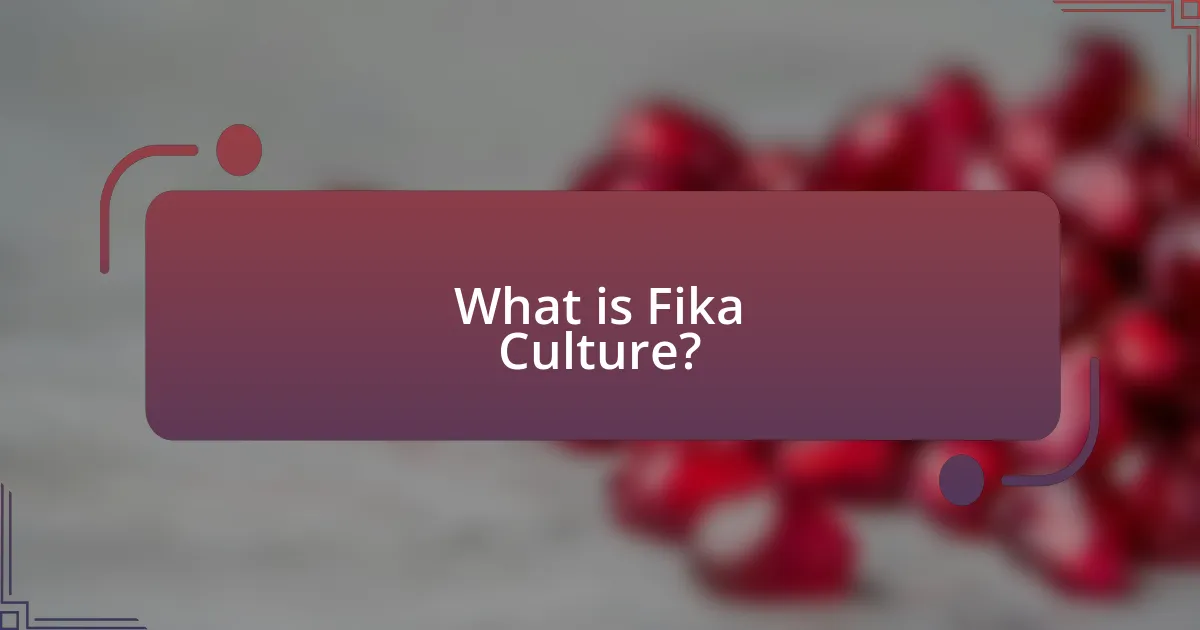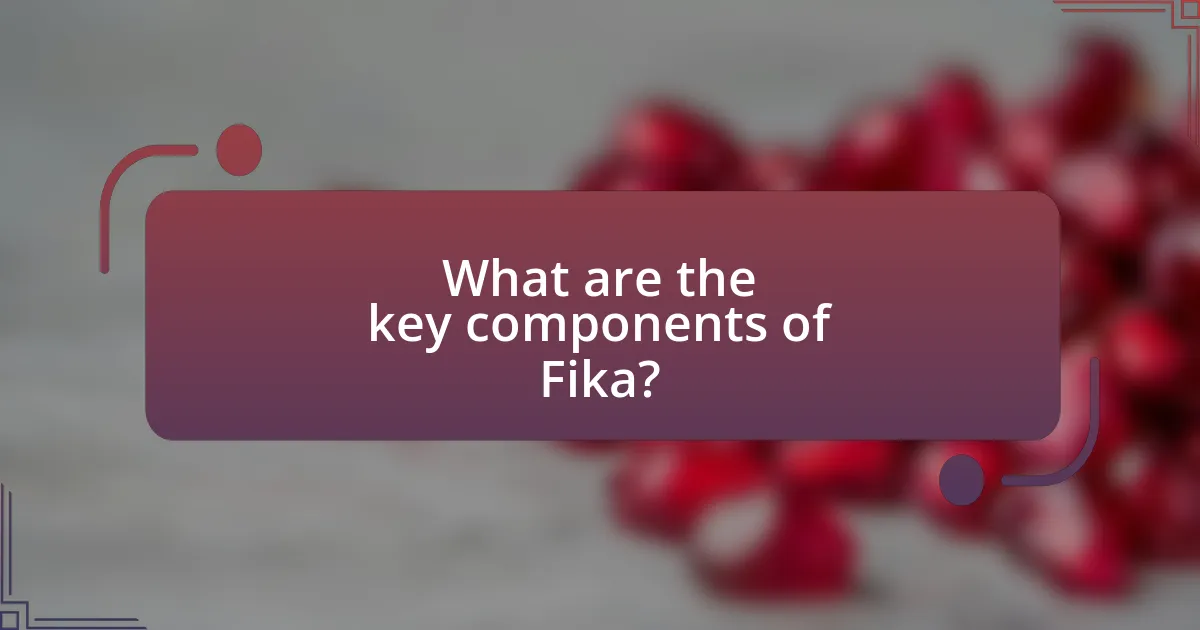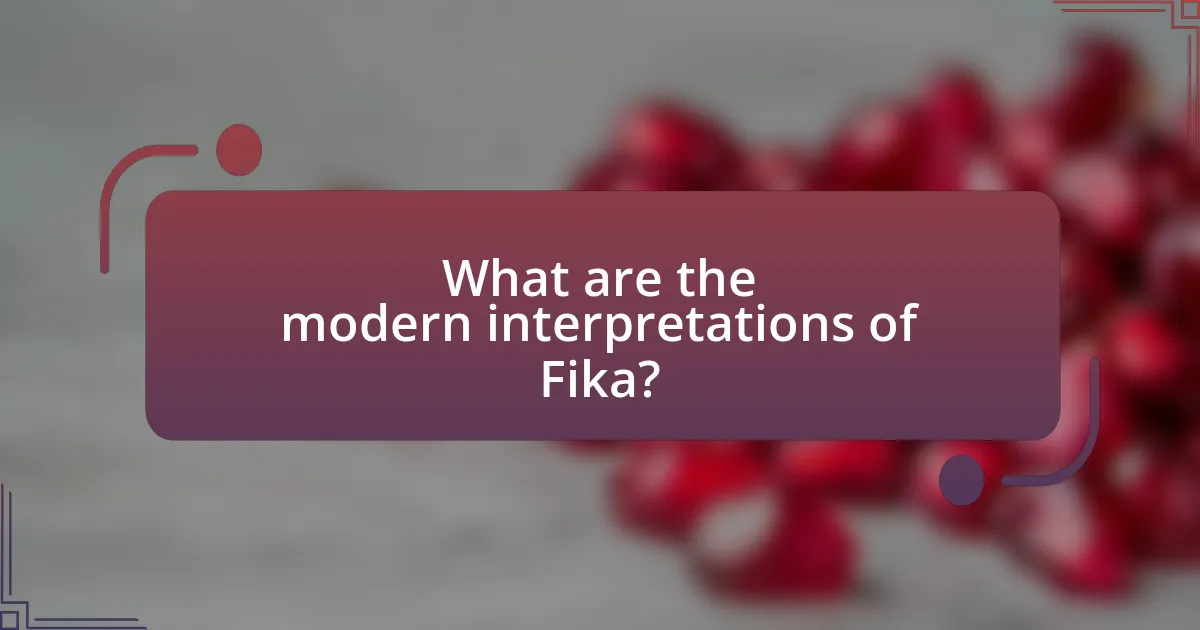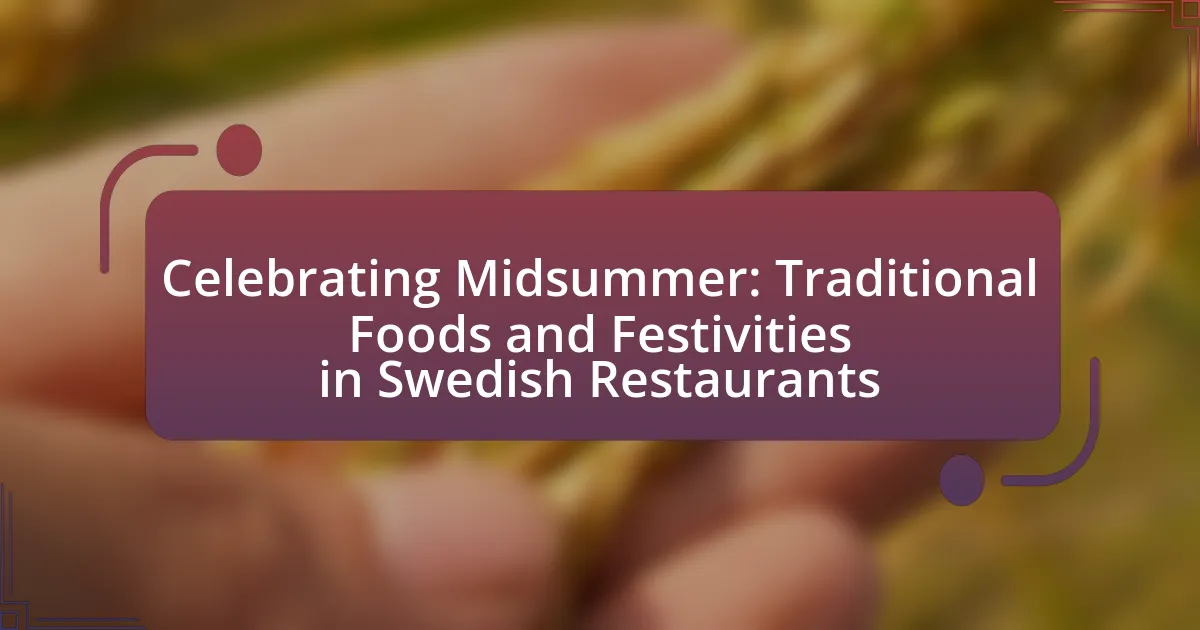Fika culture is a significant Swedish tradition that revolves around taking breaks to enjoy coffee and pastries, promoting social interaction and relaxation. Originating in the 18th century, Fika has evolved into a structured practice that enhances workplace morale and productivity while fostering community connections. The article explores the historical development of Fika, its social benefits, and its role in promoting work-life balance, as well as the key components such as preferred foods and beverages. Additionally, it examines how globalization and modern lifestyles have influenced Fika practices, offering insights into creating authentic Fika experiences at home and in various settings.

What is Fika Culture?
Fika culture is a Swedish tradition that emphasizes taking a break to enjoy coffee and pastries, fostering social interaction and relaxation. This practice is deeply ingrained in Swedish society, often occurring multiple times a day, and serves as a moment to pause and connect with others. Research indicates that fika contributes to improved workplace morale and productivity, as it encourages collaboration and strengthens relationships among colleagues. The term “fika” itself translates to “coffee break,” highlighting its central role in Swedish dining and social customs.
How did Fika Culture originate in Sweden?
Fika culture originated in Sweden as a social tradition centered around coffee breaks, which became popular in the 18th century when coffee was introduced to the country. Initially, these breaks were informal gatherings among friends and family, but they evolved into a more structured practice in the 19th century, particularly with the rise of coffee houses. The term “fika” itself, which means to have coffee, became widely used, reflecting the cultural significance of taking time to pause and enjoy coffee and pastries together. This practice emphasizes social interaction and relaxation, making it an integral part of Swedish life and work culture.
What historical events influenced the development of Fika?
The development of Fika was influenced by the introduction of coffee to Sweden in the 17th century, which became popular among the Swedish elite. The Swedish government initially banned coffee in 1756 due to concerns about its effects on health and society, but this ban was lifted in the late 18th century, allowing coffee culture to flourish. By the 19th century, coffee breaks became a social norm, particularly among workers, as industrialization led to longer working hours and the need for breaks. This historical context established Fika as a vital part of Swedish culture, emphasizing social interaction and relaxation during the workday.
How has Fika evolved over the years?
Fika has evolved from a simple coffee break into a significant cultural practice in Sweden, emphasizing social interaction and well-being. Initially, Fika was primarily a time for enjoying coffee and pastries, but over the years, it has transformed into a broader social ritual that includes discussions, networking, and relaxation. This evolution reflects changing societal values, where the importance of work-life balance and mental health has gained prominence. Today, Fika is not only a cherished tradition in homes but also a common practice in workplaces, fostering community and collaboration among colleagues.
Why is Fika important in Swedish society?
Fika is important in Swedish society because it serves as a cultural practice that promotes social interaction and work-life balance. This tradition involves taking a break to enjoy coffee and pastries, fostering connections among colleagues and friends. Research indicates that regular breaks, such as those during fika, can enhance productivity and creativity in the workplace, as noted in studies by the Swedish Institute. Additionally, fika reflects Sweden’s values of egalitarianism and community, as it encourages informal gatherings regardless of social status.
What social benefits does Fika provide?
Fika provides significant social benefits by fostering community and enhancing interpersonal relationships. This Swedish coffee break tradition encourages individuals to take time out of their busy schedules to connect with colleagues, friends, or family, promoting social interaction and collaboration. Research indicates that regular social interactions, such as those experienced during Fika, can lead to improved mental well-being and increased workplace satisfaction, as employees feel more connected and valued. Additionally, Fika serves as a cultural practice that reinforces social norms of equality and inclusivity, as it typically involves everyone gathering together, regardless of hierarchy.
How does Fika contribute to work-life balance?
Fika contributes to work-life balance by providing structured breaks that promote social interaction and mental well-being among employees. These coffee breaks allow individuals to step away from work tasks, reducing stress and enhancing productivity. Research indicates that regular breaks, such as those taken during Fika, can lead to improved focus and creativity, ultimately benefiting both personal and professional life. In Sweden, the practice of Fika is deeply embedded in workplace culture, reinforcing the importance of taking time to relax and connect with colleagues, which is essential for maintaining a healthy work-life balance.

What are the key components of Fika?
The key components of Fika are coffee, pastries, and social interaction. Fika is a traditional Swedish coffee break that emphasizes taking time to enjoy a beverage, typically coffee, alongside sweet treats like cinnamon buns or cookies. This practice fosters social connections, as it is often shared with friends, family, or colleagues, promoting a sense of community and relaxation. The cultural significance of Fika is recognized in Sweden, where it serves as a vital part of daily life, encouraging people to pause and engage in meaningful conversations.
What foods and beverages are typically enjoyed during Fika?
During Fika, traditional foods and beverages include coffee, pastries, and cakes. Coffee is the central beverage, often served black or with milk, while popular pastries include cinnamon buns, cardamom buns, and various types of cakes such as princess cake and chocolate cake. These items reflect the Swedish tradition of taking a break to enjoy quality time with friends or colleagues, emphasizing the social aspect of the experience.
What types of coffee are preferred in Fika?
In Fika, the preferred types of coffee are typically brewed coffee, often referred to as “filter coffee,” and espresso-based drinks. Filter coffee is favored for its smooth taste and is commonly served in larger quantities, allowing for leisurely sipping during the coffee break. Espresso, on the other hand, is popular for its strong flavor and is often enjoyed in smaller servings. This preference aligns with the traditional Swedish coffee culture, where the focus is on quality and the social aspect of enjoying coffee with pastries or snacks.
Which pastries are commonly served during Fika?
Pastries commonly served during Fika include cinnamon buns, known as “kanelbullar,” and cardamom buns, referred to as “kardemummabullar.” These pastries are traditional in Swedish coffee breaks and are often accompanied by coffee or tea. The popularity of these items is rooted in Swedish culture, where Fika is a cherished social ritual, emphasizing the enjoyment of baked goods alongside beverages.
How is Fika practiced in different settings?
Fika is practiced in various settings, including workplaces, homes, and cafes, each with its unique approach. In workplaces, Fika serves as a structured break where employees gather to enjoy coffee and pastries, fostering social interaction and team bonding, which can enhance productivity. In homes, Fika is often a more informal gathering among family and friends, emphasizing relaxation and conversation over coffee and baked goods. Cafes in Sweden are also central to Fika culture, providing a welcoming atmosphere for individuals or groups to enjoy their coffee breaks, often featuring traditional Swedish pastries like cinnamon buns. This practice is deeply embedded in Swedish culture, promoting well-being and community connections across different environments.
What does Fika look like in a workplace environment?
Fika in a workplace environment typically involves a scheduled coffee break where employees gather to enjoy coffee and pastries together. This practice fosters social interaction, enhances team bonding, and promotes a relaxed atmosphere, contributing to overall employee well-being and productivity. Research indicates that such breaks can improve workplace morale and creativity, as they provide a necessary pause from work tasks, allowing employees to recharge and return with renewed focus.
How does Fika differ in casual versus formal settings?
Fika in casual settings emphasizes relaxation and social interaction, often involving friends or family gathering informally over coffee and pastries. In contrast, Fika in formal settings is more structured, typically occurring in workplace environments where it serves as a professional networking opportunity, often accompanied by discussions related to work. The casual Fika allows for a more laid-back atmosphere, while the formal Fika maintains a focus on productivity and collaboration, reflecting the cultural significance of coffee breaks in Swedish dining as a means to foster relationships and enhance workplace morale.

What are the modern interpretations of Fika?
Modern interpretations of Fika emphasize its role as a social and cultural practice rather than merely a coffee break. In contemporary settings, Fika is often seen as an opportunity for connection, collaboration, and mental well-being, promoting work-life balance and fostering relationships among colleagues. Research indicates that organizations that encourage Fika can enhance employee satisfaction and productivity, as it allows for informal discussions and idea sharing. This shift reflects a broader understanding of the importance of social interactions in the workplace, aligning with studies that show breaks can improve focus and creativity.
How has globalization affected Fika culture?
Globalization has introduced diverse coffee varieties and international pastries into Fika culture, enriching the traditional Swedish coffee break experience. As global travel and communication have increased, Swedes have been exposed to various coffee brewing methods and international snack options, leading to a fusion of flavors during Fika. For instance, the popularity of specialty coffee shops and international desserts has grown in Sweden, reflecting a blend of local and global culinary influences. This evolution demonstrates how globalization has transformed Fika from a purely Swedish tradition into a more eclectic and globally inspired social ritual.
What adaptations have been made to Fika in other countries?
Fika has been adapted in various countries by incorporating local customs and flavors into the coffee break tradition. For instance, in the United States, Fika often includes a wider variety of pastries and snacks, reflecting the diverse culinary landscape, while also emphasizing a more casual social interaction compared to the traditional Swedish setting. In Australia, Fika has been embraced as part of the café culture, where it is common to enjoy specialty coffee alongside artisanal baked goods, often in a more relaxed outdoor environment. These adaptations highlight how Fika has evolved to fit different cultural contexts while maintaining its core principle of taking a break to enjoy coffee and conversation.
How do modern lifestyles influence traditional Fika practices?
Modern lifestyles significantly influence traditional Fika practices by introducing faster-paced routines and digital communication, which often reduce the time allocated for these social coffee breaks. As people increasingly prioritize work commitments and technology over face-to-face interactions, the essence of Fika—taking a moment to pause and connect—can be diminished. Research indicates that in urban areas, the average time spent on breaks has decreased, with many opting for quick coffee-to-go options instead of the leisurely gatherings that characterize traditional Fika. This shift reflects a broader trend where convenience and efficiency take precedence over the cultural significance of shared moments, thereby altering the way Fika is experienced in contemporary society.
What are some best practices for enjoying Fika?
To enjoy Fika, prioritize taking a break from work or daily activities to relax and socialize. This practice emphasizes the importance of slowing down and connecting with others over coffee and pastries, which is a core aspect of Swedish culture. Engaging in meaningful conversations during Fika enhances the experience, as studies show that social interactions can improve mental well-being. Additionally, selecting high-quality coffee and traditional Swedish pastries, such as cinnamon buns or cardamom bread, contributes to the authenticity of the experience.
How can one create an authentic Fika experience at home?
To create an authentic Fika experience at home, one should focus on serving high-quality coffee alongside traditional Swedish pastries, such as cinnamon buns or cardamom rolls. The essence of Fika lies in taking a break to enjoy these treats while engaging in meaningful conversation, reflecting the cultural importance of social connection in Sweden. Research indicates that Fika is not just about the food and drink; it emphasizes the value of slowing down and appreciating the moment, which is integral to Swedish dining culture.
What tips can enhance the enjoyment of Fika with friends and family?
To enhance the enjoyment of Fika with friends and family, create a warm and inviting atmosphere by choosing a comfortable setting and incorporating cozy elements like soft lighting and pleasant music. This approach fosters relaxation and encourages conversation, which is essential for the Fika experience. Additionally, offering a variety of traditional Swedish pastries, such as cinnamon buns or cardamom bread, alongside quality coffee can elevate the tasting experience, as these items are integral to authentic Fika. Engaging in meaningful conversations and sharing personal stories during the break can strengthen bonds and make the gathering more memorable, aligning with the cultural significance of Fika as a time for connection and reflection.





